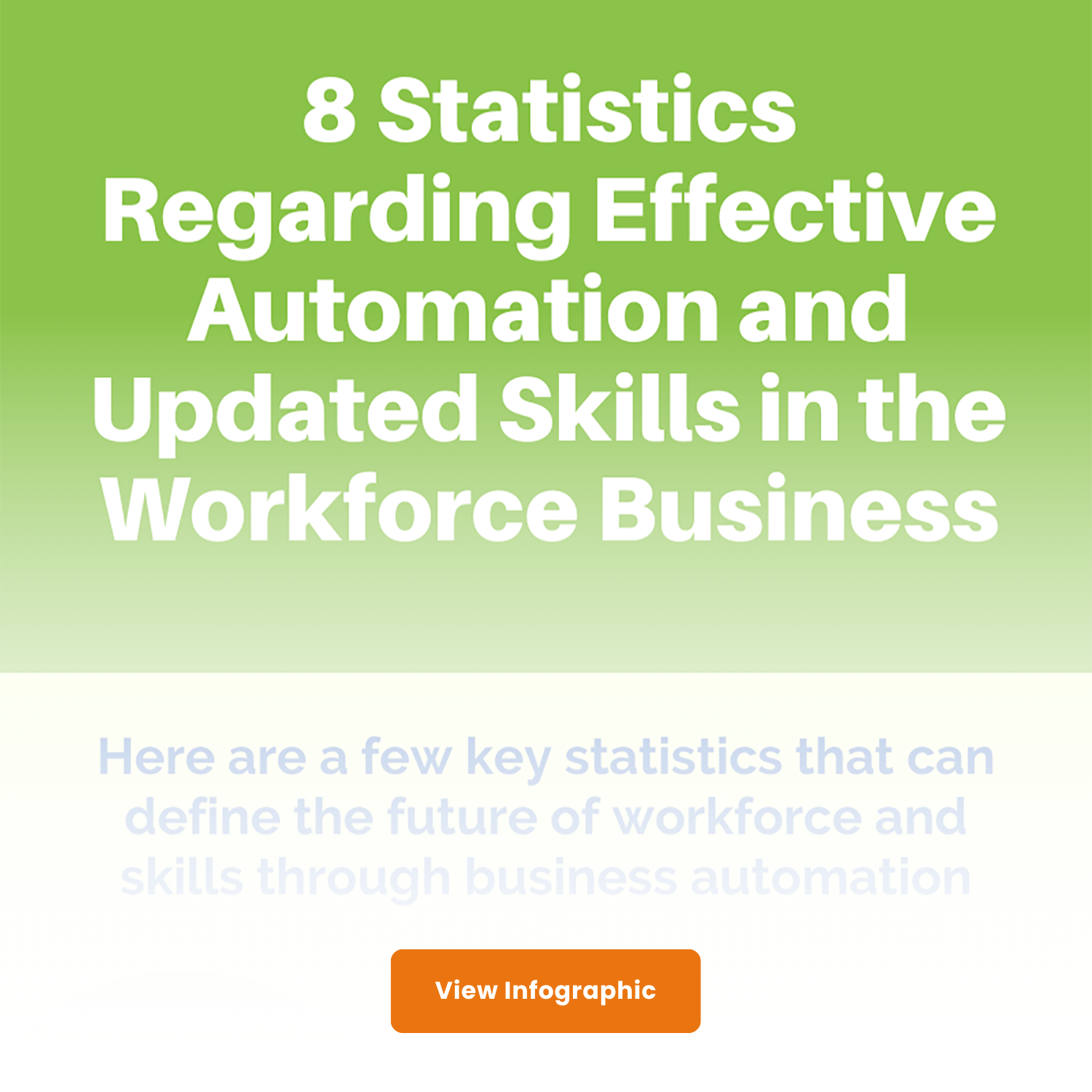
In the last few years, the growth and need for automation were in a boom; the increased IT requirements and low available resources made it very demanding. Ever since the pandemic happened, every business has needed to implement automation techniques to improve their workflow with available forces. Here are some workflow automation statistics that is hitting 2024 and how it will affect the future.
Statistics and Trends for Business Adoption of Workflow Automation in 2024
What happens when a business refuses to take an advancement that all of its competitors take? They are going to lose their market share to the other players; this explains why automation is spreading like wildfire among all industries worldwide.
- 94% of corporate company executives would prefer to utilize a unified platform to integrate their apps and implement process automation than rely on several platforms.
- More than 1/3 of businesses have five or more automated divisions.
- 45% of corporate teams are involved in the automation process.
- At least one function in 31% of organizations is automated.
- Almost 70% of employees agree that automation will allow them to qualify for higher-paying jobs.
- 57% of organizations want to use automation to boost employee productivity and performance.
- Marketers want seamless connectivity with existing content management, CRM, and ERP systems, according to 50% of respondents.
- In a Gartner poll, more than 85% of CIOs stated they were active in their organization’s sustainability activities.
- In the United States, one-third of new employment are for occupations that didn’t exist 25 years ago.
- No-Code Low-Code process automation solutions have been implemented by 24% of businesses.
- More than 80% of corporate executives said they were speeding up work process automation and expanding their use of remote workers.

Also read: Top 75 Digital Transformation Statistics and Trends To Help You Navigate it
Need for Workflow Automation Statistics and Trends
Almost every business has adopted at least one automated process. It is one of the most discussed topics of this time, but did you ever think, why is it that important to adopt automation? What does it do to a business? Then here are some stats to clear your doubts. Also, you can Test Your Process’s Automation Potential here.
- According to 97 % of corporate executives, a Lack of alignment influences the outcome of a job.
- Office workers manually hunt for files for more than 50% of their time.
- In 90% of accidents, human error is a contributing factor.
- Since 85 % of data is unstructured, workflow automation is critical for a business to save time and minimize mistakes.
- According to McKinsey, automation may boost global productivity growth by 0.8-1.4 % every year.
- In order to cut operational expenses, 24% of businesses would use job automation.
- Task switching costs 40% of productivity, which may be decreased by automating most processes.
- According to HBR, poor data costs US businesses $3 trillion every year.
- Automation software reduces labour costs, agrees 31% of business leaders.
- 50% of sales time is wasted on unproductive prospecting.
- 40% of productivity is lost to task-switching.
- 70% of the business leaders report that they spend 45 minutes to 3 hours on repetitive tasks, from an 8-hour workday.
- Employees estimate that automating tasks might save them 240 hours per year, while company leaders feel that automating tasks could save them 360 hours per year.
Also Read: 11 Tips to Selecting the Right Workflow Automation Software

Business Automation Stats
- The worldwide industrial automation market was valued at USD 196.6 billion in 2021 and is expected to exceed USD 412.8 billion by 2030, growing at an anticipated CAGR of 8.59% from 2022 to 2030.
- An Oxford report estimates that implementing automation in the manufacturing industry could increase $4.9 trillion every year by 2030. The market is estimated to increase at a 6.6% CAGR between 2023 and 2028.
- When asked what business process automation is, 81% of the decision-makers polled in the State of Process Orchestration Report said they knew what it was. When given a definition, 90% said their business is doing it, with half (49%) stating they certainly are.
- Gartner said investment in hyper-automation-enabling software solutions would exceed $720 billion.
- According to an Accenture survey, using AI to automate or enhance operations would result in considerable profit increases across a wide range of businesses by 2035.
- 91% of respondents of the State of Process Orchestration Report indicate their firm intends to expand investment in process automation over the next 24 months, up from 88% last year.
Also Read: Top Product Management Statistics
Marketing Workflow Automation Trends for 2024
- 40% of those who aren’t utilizing marketing automation aim to do it soon.
- Conversions increased for 77 % of marketers that used marketing automation solutions.
- 51% of companies are now using marketing automation.
- Marketing automation is presently used by 51 % of businesses. More than half of B2B enterprises (58%) want to implement the technology.
- According to Research and Markets, the worldwide marketing automation industry will be worth USD 8.42 billion by 2027.
- 80% of marketers saw an increase in the number of leads after using marketing automation software.
- B2B marketers who use marketing automation raised their sales pipeline rate by 10% on average.
- More than 60% of businesses outsource marketing automation in some form or another.
- 43% of marketers say optimizing productivity is the most important objective of a marketing automation plan.
- 63% of marketers expect to increase their marketing automation spending in the near future.
- At least 1 type of marketing automation technology is used by 75% of all businesses.
Also Read: Top Marketing Automation Trends: The Future is Now
Workflow Automation Statistics for different departments
- The engineering and IT department handle about 40% of an organization’s automation.
- According to the HIMSS Future of Healthcare Report, almost 80% of healthcare providers want to considerably boost their expenditures in digital healthcare solutions over the next five years.
- As per the Bureau of Labour Statistics, the need for healthcare administration personnel is predicted to grow by 18% between 2018 and 2028.
- According to experts, financial automation can save up to 90% of the operational cost.
- According to Mckinsey, Retailer automation investments are expected to drive considerable industry growth: the warehouse automation market will reach $51 billion by 2030, with a CAGR of 23%.
- Feedback gathering is automated in most organizations as agreed by 65% of the customer service experts.
- According to 37% of the IT leaders, their customer service departments have in the company.
- According to the survey, one in ten business leaders agrees that automation can make hiring easy.

Future of Workflow Automation statistics
- To improve customer experience, 57% of enterprises plan to adopt automation methods in the coming two years.
- 64% of corporate business experts expect to implement automation to boost employee experience in the next two years.
- According to Gartner, the market of the software that enables hyperautomaiton will reach up to $1.04 trillion, with a CAGR of 11.9%
- By 2024, Gartner predicts that 69 % of daily management tasks will be completely automated.
- Automation is one of the fastest-expanding software sectors, with a current market value of $6.1 billion and a forecasted growth rate of 200% .
- By 2030, one out of every four occupations in the United States will be at risk of becoming automated.
- In the coming years, humans will account for 58% of all work, with machines managing the remaining 42%.
- According to Gartner, integrating hyper-automation technology with improved operational procedures would reduce operational expenses by 30% by 2024.
- In the long run, up to 2030, automation might enhance productivity and help reduce the economic growth gap in the world’s 20 largest nations.
- By 2025, the market for workflow automation procedures is predicted to grow to $26 billion, up from less than $5 billion in 2018.
- According to a recent Gartner poll, more than 80% of companies plan to keep or grow their investment in automation solutions.
- According to a McKinsey & Co. worldwide survey, 66% of organizations have experimented with business process automation in one or more business functions. This is a considerable increase of 9% over the previous year’s poll of 57%.
Explore Infographic: Workflow Automation Benefits
The challenge that Workflow Automation brings – Forecast and Statistics
As automation involves introducing IT into it, as usual, it brings up the need for knowledge in IT as a qualification benchmark which will affect the job of many, and many aspirants will get disqualified from this stage only. Here are some of the stats on the challenges of automation for 2024.
- In the United States, 24% of employees needing a bachelor’s degree and 55% of positions with lower prerequisites have the potential to be automated.
- In the United States, the youngest workers (aged 16 to 24) have the highest average risk of automation exposure (49%).
- In the United States, 70% of ordinary physical and cognitive works are at risk of being automated.
- The transportation, warehousing, and manufacturing industries will lose the most employment due to automation.
- The education and social work industries will lose the fewest employment due to automation.
- By 2030, factors such as remote work, e-commerce, and further automation may force more than 100 million employees to change careers.
Conclusion
The above-mentioned workflow automation statistics are only depicting how important it is for a business to automate workflows in 2024. The benefits it serves are insurmountable in terms of resource-saving and efficiency. If you’re already automating your workflows, you can see possibilities and opportunities here, but if you aren’t, then you can foresee the industrial threat and how it’ll take off your competitive advantage over time. Today, wherever you are standing in your automation journey, it is high time to take that leap and invest your time in the company’s strategic growth.
Frequently Asked Questions (FAQs)
What is workflow automation?
Workflow automation refers to the use of technology to streamline and automate repetitive tasks, processes, and workflows within an organization. It involves the use of software or tools to automate manual steps, decision-making, and communication, resulting in increased efficiency and reduced manual effort.
How does workflow automation improve efficiency?
Workflow automation improves efficiency by eliminating manual and repetitive tasks, reducing human error, and streamlining processes. It enables the automatic routing of tasks, notifications, and approvals, saving time and allowing employees to focus on more valuable and strategic work.
What are the benefits of implementing workflow automation?
Implementing workflow automation offers several benefits, including increased productivity, reduced operational costs, improved accuracy, faster task completion, enhanced collaboration, better visibility into processes, and the ability to scale operations effectively.
What are some common use cases for workflow automation?
Common use cases for workflow automation include automating document approvals, employee onboarding and offboarding processes, purchase order processing, invoice management, customer support ticket routing, project management workflows, and marketing campaign coordination.
Subscribe
Login
Please login to comment
0 Comments
Oldest















